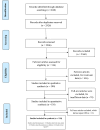Association of greenspaces exposure with cardiometabolic risk factors: a systematic review and meta-analysis
- PMID: 38509487
- PMCID: PMC10953288
- DOI: 10.1186/s12872-024-03830-1
Association of greenspaces exposure with cardiometabolic risk factors: a systematic review and meta-analysis
Abstract
Background: Cardiometabolic conditions are major contributors to the global burden of disease. An emerging body of evidence has associated access to and surrounding public open spaces (POS) and greenspace with cardiometabolic risk factors, including obesity, body mass index (BMI), hypertension (HTN), blood glucose (BG), and lipid profiles. This systematic review aimed to synthesize this evidence.
Methods: This systematic review was conducted based on the PRISMA guidelines. Four electronic databases including Web of Science, PubMed, Scopus, and Google Scholar were searched for eligible articles published until July 2023. All observational studies which assessed the association of greenspace and POS with cardiometabolic risk factors including obesity, BMI, HTN, BG, and lipid profiles were included and reviewed by two authors independently. Heterogeneity between studies was assessed using the I2 index and Cochrane's Q test. Random/fixed effect meta-analyses were used to combine the association between greenspace exposure with cardiometabolic risk factors.
Results: Overall, 118 relevant articles were included in our review. The majority of the articles were conducted in North America or Europe. In qualitative synthesis, access or proximity to greenspaces or POS impacts BMI and blood pressure or HTN, BG, and lipid profiles via various mechanisms. According to the random effect meta-analysis, more access to greenspace was significantly associated with lower odds of HTN (odds ratio (OR): 0.81, 95% confidence intervals (CIs): 0.61-0.99), obesity (OR: 0.83, 95% CIs: 0.77-0.90), and diabetes (OR:0.79, 95% CI: 0.67,0.90).
Conclusions: Findings of this systematic review and meta-analysis suggested that greenspace accessibility is associated with some cardiometabolic risk factors. Improving greenspace accessibility could be considered as one of the main strategies to reduce cardiometabolic risk factors at population level.
Keywords: Blood pressure; Cardiometabolic; Greenspace; Hyperglycemia; Lipid profiles; Natural space; Parks; Urban environment.
© 2024. The Author(s).
Conflict of interest statement
The authors declare no competing interests.
Figures



Similar articles
-
Normal Weight Obesity and Cardiometabolic Risk Factors: A Systematic Review and Meta-Analysis.Front Endocrinol (Lausanne). 2022 Mar 24;13:857930. doi: 10.3389/fendo.2022.857930. eCollection 2022. Front Endocrinol (Lausanne). 2022. PMID: 35399938 Free PMC article.
-
Potato Intake and the Risk of Overweight/Obesity, Hypertension, Diabetes, and Cardiovascular Disease: A Systematic Review and Meta-analysis of Observational Studies.Nutr Rev. 2025 Mar 1;83(3):466-478. doi: 10.1093/nutrit/nuae159. Nutr Rev. 2025. PMID: 39527022
-
The impact of urbanisation on the cardiometabolic health of Indigenous Brazilian peoples: a systematic review and meta-analysis, and data from the Brazilian Health registry.Lancet. 2022 Dec 10;400(10368):2074-2083. doi: 10.1016/S0140-6736(22)00625-0. Lancet. 2022. PMID: 36502845
-
Cardiometabolic factors and population risks of cardiovascular disease in community-dwelling adults with varied blood pressure statuses.Diabetes Obes Metab. 2024 Aug;26(8):3261-3271. doi: 10.1111/dom.15653. Epub 2024 May 13. Diabetes Obes Metab. 2024. PMID: 38738333
-
Effects of cocoa consumption on cardiometabolic risk markers: Protocol for a systematic review and meta-analysis of randomized controlled trials.PLoS One. 2024 Sep 9;19(9):e0309824. doi: 10.1371/journal.pone.0309824. eCollection 2024. PLoS One. 2024. PMID: 39250491 Free PMC article.
Cited by
-
Green spaces, blue spaces and human health: an updated umbrella review of epidemiological meta-analyses.Front Public Health. 2025 May 22;13:1505292. doi: 10.3389/fpubh.2025.1505292. eCollection 2025. Front Public Health. 2025. PMID: 40475205 Free PMC article.
References
-
- Hutto D, Jr, Barrett K. DO OPEN SPACES WITHIN AN URBAN MATRIX INCREASE ANURAN ABUNDANCE? Herpetological Conserv Biology. 2022;17(3):582–92.
Publication types
MeSH terms
Substances
LinkOut - more resources
Full Text Sources

